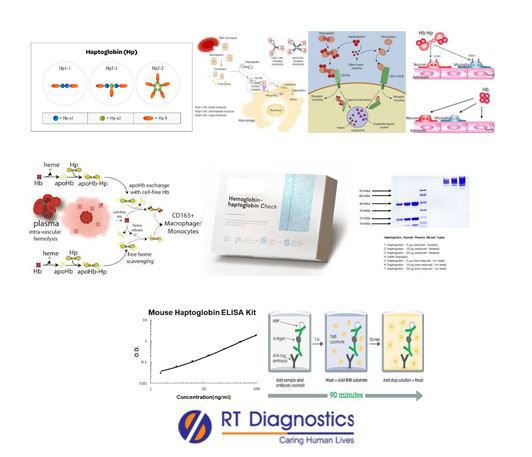Haptoglobin:
Why Haptoglobin Test?
CLINICAL INFORMATION
Haptoglobin is an acute-phase protein (synthesized by the liver, induced by inflammatory cytokines like IL-6, IL-1 and TNF) that also has an antioxidant property (reduces oxidative stress), apart from its antibacterial activity, angiogenesis (formation of new blood vessels through VEGF signalling pathway) and tissue repair. Anti-inflammatory action is caused by haptoglobins since it has the ability to suppress the production of inflammatory cytokines like TNF-alpha, IL-10 and IL-12. Thus serum haptoglobin concentrations display bi-directional changes during inflammation. Haptoglobin protein binds to free haemoglobin, thus it prevents haemoglobin-induced inflammation and oxidative tissue damage, inhibits loss of iron from RBC lysis that occurs in our body and furthermore it prevents renal (kidney) damage. Two common variants of haptoglobin are Hp-1 and Hp-2. Haptoglobin test is most often used to diagnose hemolytic anaemia eg. Immune-hemolytic anaemia etc. Indications for low levels of haptoglobins include anemia (during abnormal RBC lysis eg. Hereditary spherocytes, Sickle cell disease or thalassemia, G6PD deficiency, erythroblastofetalis, paroxysmal nocturnal hemoglobinuria, drug induced hemolytic anemia, uremia etc), the haptoglobins bind to the circulating hemoglobins (thus forms Haptoglobin-Hemoglobin Complex) and thus the levels of free haptoglobins levels drop in the blood stream), prosthetic heart valves, sub-acute bacterial endocarditis, reaction to blood transfusion, ulcers, cancers, poor-iron diet, liver diseases (cirrhosis), obstructive jaundice, pregnancy, bone marrow scarring eg. Myelofibrosis, infections like mononucleosis etc whereas high haptoglobin indicate diseases associated with major depression, ESR, infections with acute phase protein reactants (since haptoglobin is an acute phase protein), obesity, smoking, burns, surgery, trauma, inflammation, hepatitis, obstructive or biliary diseases, amyloidosis, collagen diseases, acute rheumatic disease, heart attack, ulcerative colitis, peptic ulcer, nephritis, neoplasia, pyelonephritis, UTI, Pneumonia, tissue destruction like MI, ongoing infection, pathologies of WBCs such as leukemia and lymphoma etc. Clinical manifestations or symptoms of hemolytic anaemia include severe fatigue, pale skin, cold hands and feet, shortness of breath, hypotension, jaundice, upper abdominal pain, dizziness, lightheadedness, shortness of breath, arrhythmias (abnormal heartbeat), dark-coloured urine, hematuria, enlarged spleen, autoimmune disorders, toxins like lead and copper poisoning, snake and spider bites, blood vessel damage eg. Thrombotic thrombocytopenic purpura etc. Certain medical underlying conditions can alter this Haptoglobin test result namely rheumatoid arthritis, ulcerative colitis, chronic liver disease etc. Some medications that can affect this haptoglobin test result include corticosteroids, androgens, OCPs, chlorpromazine, quinidine, nitrodiphenhydramine, indomethacin, nitrofurantoin, quinidine, streptomycin, isoniazid etc. Other tests include CBC, blood smear, haemoglobin, hematocrit, reticulocyte count, anti-globulin test, indirect bilirubin test, lactate dehydrogenase, G6PD etc.

General Instructions:
Sample Requirement: Specimen - Blood sample collected from the vein. Test Preparation: None.
NOTE - Sample for specimen collections may vary based on the patient’s condition / cases according to the patient’s presenting complaints/signs or symptoms:
SPECIMEN REQUIREMENT (Special or Rare Cases) - As instructed and guided by Physician / Clinician / Pathologist / as per Laboratory’s requirements, according to procedures and protocols.
This Multi-Specialty Clinical Referral Laboratory RT DIAGNOSTICS provides precise and accurate tests with an extensive range of testing services to the medical centres to help in the diagnosis and identification of pathology in the test specimens for infectious diseases and also to evaluate the function of organ systems of the patient. It prevents further complications and helps to stabilize and restore health to near normalcy at the earliest without delay.



